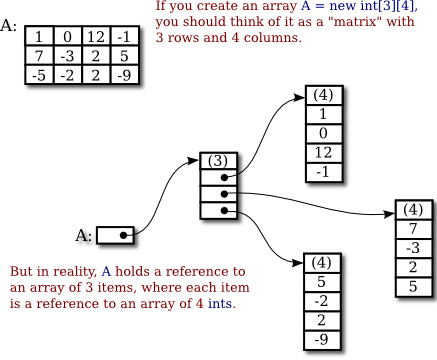

It prints zero because we did not set values to array, so all the elements of the array initialized to 0 by default. We iterate the array to access its elements and it prints five times zero to the console. In the above example, we created an array arr of int type and can store 5 elements. We can combine both declaration and initialization in a single statement. Unlike the Arraylist Class, the primitive array (lowercase a) holds a fixed. Moreover, in Java, an array is a collection of similar type of elements which has contiguous memory location. The arrayName is the name of array, new is a keyword used to allocate memory and size is length of array. An array is a special construct whose purpose is to store multiple values in a single variable, instead of declaring separate variables for each value. New operator is used to initialize an array.

Initialization Syntax arrayName = new datatype At the time of initialization, we specify the size of array to reserve memory area. Initialization is a process of allocating memory to an array. The arrayName can be any valid array name and datatype can be any like: int, float, byte etc. Java allows to declare array by using both declaration syntax, both are valid. You can get all the elements of array by just increment its index by one. Single dimensional array use single index to store elements. It occupies a contiguous memory location.It is a collection of similar data types.It allows to store primitive values or reference values.Īrray can be single dimensional or multidimensional in Java. In Java, array is treated as an object and stores into heap memory. It is also known as static data structure because size of an array must be specified at the time of its declaration.Īrray starts from zero index and goes to n-1 where n is length of the array. Array is a container object that hold values of homogeneous type. Connecting to Access using Type-1 DriverĪn array is a collection of similar data types.Method Overriding with Exception Handling.Difference between Classes And Interface.See the examples below for accessing single element and using an enhanced for loop for accessing array elements. You may use the array index in square brackets to access elements individually. The array elements can be accessed by using the numeric index that starts at 0.
#JAVA ARRAY DECLARATION HOW TO#
String anArrayOfStrings //used in one of the above example How to access Java array elements For example:īyte byteArray //It will create an array of byte data type Similarly, you may create arrays by using any of the above ways for different data types. In that way, the number of elements given in the array becomes the length of that array. In the right side, the array element values are given in the curly braces. So, you have to specify the data type which is followed by array name on the left side. You may also create array elements at the time of declaration. This is important while accessing the array elements as shown in the section below.Ĭreating array elements with shortcut syntax There, you may notice the array element index starts at 0. After creating this array, you may assign values to the array elements as follows: Note, the array in Java may contain fixed number of elements.
#JAVA ARRAY DECLARATION CODE#
This line of code will allocate the memory of five elements which data type is the integer. In this way, the array is created with five elements. One way is to use the new keyword as follows: As shown in above two examples, the arrays in Java can be created by different ways.


 0 kommentar(er)
0 kommentar(er)
